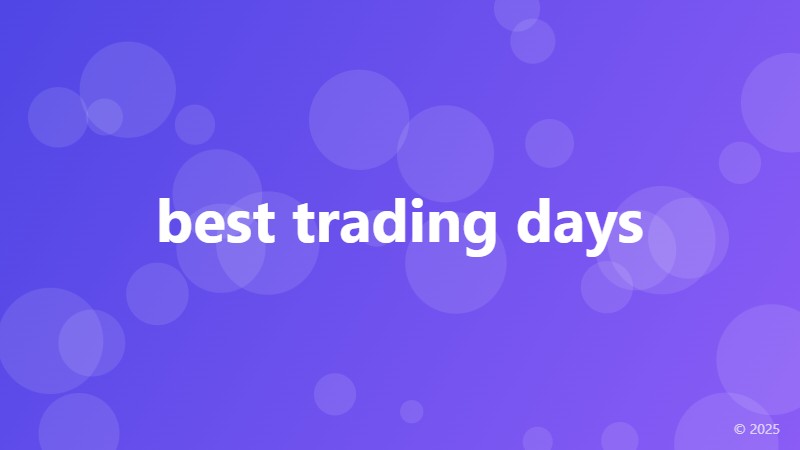best trading days

Understanding the Concept of Best Trading Days
When it comes to trading, timing is everything. Identifying the best trading days can significantly impact your profits and overall performance. But what makes a trading day "best"? Is it a specific day of the week, month, or quarter? Or is it a particular market condition or event? In this article, we'll delve into the concept of best trading days and explore the factors that influence them.
The Importance of Market Volatility
Market volatility is a key factor in determining the best trading days. When markets are volatile, prices fluctuate rapidly, creating opportunities for traders to profit from the fluctuations. However, high volatility also increases the risk of losses. Traders need to be able to navigate these conditions effectively to maximize their gains.
Research has shown that certain days of the week and month tend to be more volatile than others. For example, Mondays and Fridays tend to be more volatile than Tuesdays and Wednesdays. This is because Mondays often see a continuation of the previous week's trends, while Fridays are influenced by traders' decisions to close out positions before the weekend.
The Role of Economic Indicators
Economic indicators, such as GDP growth rates, inflation rates, and employment numbers, can also impact the best trading days. These indicators provide insight into the overall health of the economy and can influence market sentiment. For example, a strong GDP growth rate may boost market confidence, leading to increased trading activity and higher prices.
Traders need to stay up-to-date with economic indicators and understand how they impact the markets. This enables them to make informed trading decisions and capitalize on opportunities as they arise.
The Influence of Seasonality
Seasonality also plays a significant role in determining the best trading days. Certain times of the year, such as the start of a new quarter or the holiday season, can impact market activity. For example, the "January effect" refers to the tendency of stocks to perform well in January, as investors seek to take advantage of lower prices after the holiday season.
Traders who understand seasonality can use this knowledge to their advantage, positioning themselves to profit from predictable market patterns.
Identifying the Best Trading Days
So, what are the best trading days? While there is no one-size-fits-all answer, research suggests that certain days of the week and month tend to be more profitable than others. For example:
- Mondays: High volatility and a continuation of the previous week's trends make Mondays a popular day for traders.
- Fridays: The approach of the weekend and the desire to close out positions create opportunities for traders.
- Options expiration Fridays: The third Friday of each month, when options contracts expire, can be a particularly active trading day.
- First trading days of the month: The start of a new month often sees increased trading activity as investors adjust their portfolios.
It's essential to remember that these are general trends and that market conditions can change rapidly. Traders need to stay flexible and adapt to changing circumstances to maximize their profits.
Conclusion
In conclusion, identifying the best trading days requires a deep understanding of market volatility, economic indicators, and seasonality. By recognizing these factors and positioning themselves accordingly, traders can increase their chances of success. Remember, there is no one-size-fits-all approach to trading, and what works for one trader may not work for another. Continuous learning and adaptation are key to achieving long-term trading success.